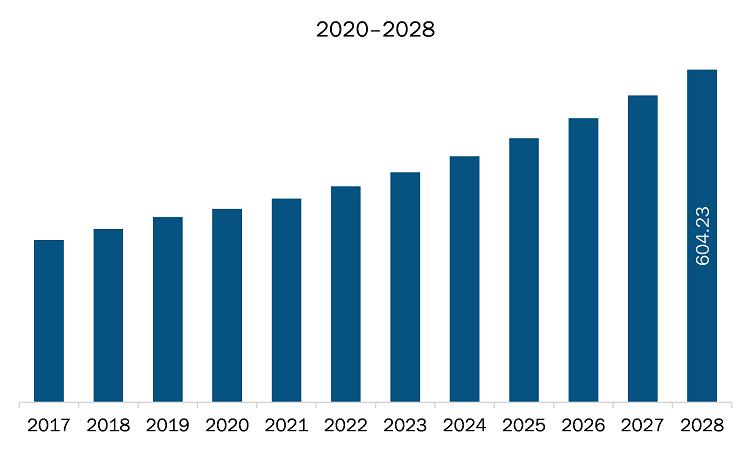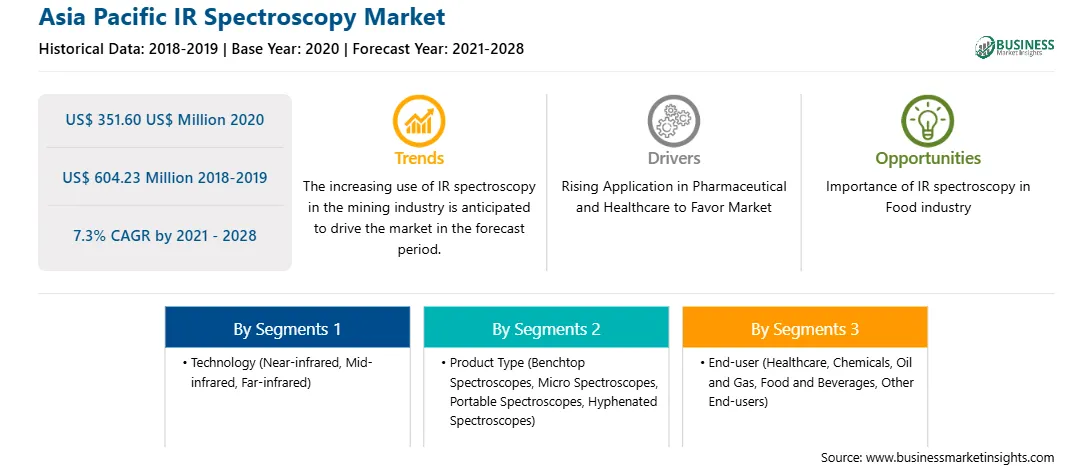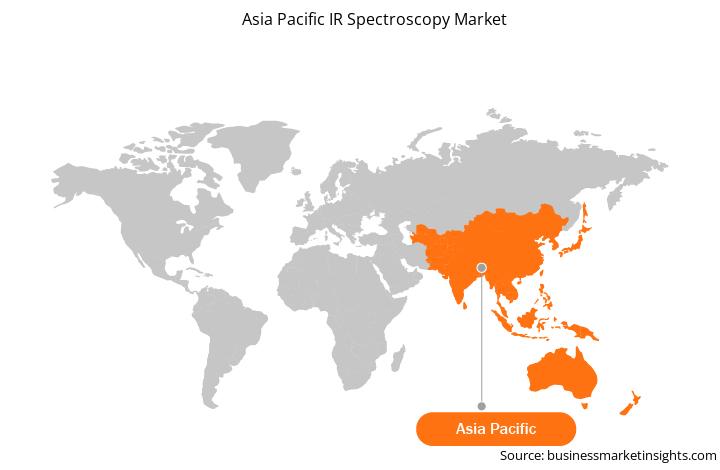The presence of developing economies such as China, India, South Korea, Malaysia, the Philippines, and Taiwan helps in making Asia a developing region. Stable economies and technological advancements support the growth of diversified industries and markets in Asia. The healthcare industry of Asia is growing owing to the increasing scope of home care, medical tourism, and rising number of hospitals. Also, the implementation of advanced technologies such as IR spectroscopes is positively impacting the healthcare industry. Countries such as China is investing a significant amount to strengthen their healthcare industry. For instance, amid COVID-19, when Chinese government and QVIA Pharma Audits witnessed adverse impact on life science & healthcare industry, the government has proposed plans to boost the investment in healthcare. Therefore, IQVIA has focused on building new healthcare infrastructure by putting efforts in intensive care units and adopting hospital digital solutions. Integration of new technologies and building new healthcare units will help the healthcare professionals to analyze sample and diagnose disease. Additionally, Malaysia, Singapore, Taiwan, and South Korea, are the other Asian countries known for housing medically advanced institutions and attracting a large number of patients across the world. Apart from growing healthcare industry, China, Japan, and India are the key chemical producing countries in the world. The large chemical production capabilities have underlined the need for analyzing chemicals to detect and quantify information with respect to molecules and atoms in elemental composition. Also, imprints of companies such as Hitachi Ltd.; JASCO International Co., Ltd.; and Shimadzu Corporation in the region holds a significant position in boosting both production and sales cycle of IR spectroscopes among diversified industries, thereby influencing the market growth.
According to latest situation report from the World Health Organization (WHO), India, Australia, Japan, and China are some of the worst affected countries due to COVID-19 outbreak. The COVID-19 crisis is affecting the industries worldwide and the global economy is anticipated to take a worst hit in 2020 and likely in 2021. The outbreak has created significant disruptions in primary industries such as food & beverage, medical, energy & power, electronics & semiconductor, petroleum, and chemicals. A sharp decline in the growth of mentioned industrial activities is impacting the growth of the APAC IR spectroscopy market as they are the major supply and demand sources for IR spectroscopy products and solutions. The factory shutdowns, travel bans, trade bans, and border lockdowns to combat and contain the outbreak have impacted manufacturing, supply, and sales of various electronic components that are required for the manufacturing of IR spectroscopy. Asia Pacific is characterized by the presence of a large number of developing countries, positive economic outlook, high industrial presence, and huge population. All these factors make APAC a major region for the growth of various markets including IR spectroscopy. The lockdown of various plants and factories in all economies of the region is affecting the global supply chains and negatively impacting the manufacturing, delivery schedules, and sales of various products and services. In addition to this, the region is a global manufacturing hub with countries, such as China, Japan, South Korea, and India, leading the global manufacturing industry growth. Disruptions in manufacturing units has stopped the production of new IR spectroscopes, thus negatively impacted the market growth. On the contrary, the government is lifting lockdowns in all the countries, which is projected to positively impact the production and development of new spectroscopes. Also, in the wake of COVID-19, as IR spectroscopes are widely used among pharmaceutical industry for the formation of medicines, spectroscopes will play a vital role in analyzing the same.

Strategic insights for the Asia Pacific IR Spectroscopy provides data-driven analysis of the industry landscape, including current trends, key players, and regional nuances. These insights offer actionable recommendations, enabling readers to differentiate themselves from competitors by identifying untapped segments or developing unique value propositions. Leveraging data analytics, these insights help industry players anticipate the market shifts, whether investors, manufacturers, or other stakeholders. A future-oriented perspective is essential, helping stakeholders anticipate market shifts and position themselves for long-term success in this dynamic region. Ultimately, effective strategic insights empower readers to make informed decisions that drive profitability and achieve their business objectives within the market.

| Report Attribute | Details |
|---|---|
| Market size in 2020 | US$ 351.60 US$ Million |
| Market Size by 2028 | US$ 604.23 Million |
| Global CAGR (2021 - 2028) | 7.3% |
| Historical Data | 2018-2019 |
| Forecast period | 2021-2028 |
| Segments Covered |
By Technology
|
| Regions and Countries Covered | Asia-Pacific
|
| Market leaders and key company profiles |
The geographic scope of the Asia Pacific IR Spectroscopy refers to the specific areas in which a business operates and competes. Understanding local distinctions, such as diverse consumer preferences (e.g., demand for specific plug types or battery backup durations), varying economic conditions, and regulatory environments, is crucial for tailoring strategies to specific markets. Businesses can expand their reach by identifying underserved areas or adapting their offerings to meet local demands. A clear market focus allows for more effective resource allocation, targeted marketing campaigns, and better positioning against local competitors, ultimately driving growth in those targeted areas.

The Asia Pacific IR spectroscopy market is expected to grow from is expected to reach US$ 604.23 million by 2028 from 351.60 US$ million in 2020. The market is estimated to grow at a CAGR of 7.3% from 2021 to 2028. The food industry has continuously strived to be in consonance with the modern developments that have taken place in the food processing. A few aspects that have been enhanced by the implementation of the latest technologies include value addition, freshness, varied flavor and textures, and preservation of nutrient profile. The NIR spectrometers have a broad array of application in agro-food, food units, and many other fields. In agro-food industry, the IR spectroscopy application comprises chemical detection, pesticide residue detection, physical hazards detection, microbiological hazard detection, and food safety & traceability. Moreover, in food industry, the spectrometers deal with different fields of agricultural products such as crops, fruits, vegetables, oil & beverages, and dairy products.
The method of observing product’s biochemical qualities, such as skin and flesh color, respiration rate, firmness, content of sugars/pigments/organic acids/volatile and phenolic compounds, and ethylene production, is becoming a huge concern. Therefore, due to expanding scope of product authenticity and quality, and exposure of falsely labeled foods, the demand for IR spectroscopy in food industry is increasing.
Moreover, IR spectroscopy is the leading technology used during the analysis of raw materials, process control, and specifications of the final product in dairy industry. Techniques such as near-infrared and mid-infrared are successfully deployed for assessing milk and dairy product’s quality such as milk powder, whey, whole-plant corn silage (WPCS), and cheese. For instance, Teixeira et al., has determined spectroscopic patterns of antibiotics isolated in milk for detecting minimum amounts of compounds precisely and rapidly. The FTIR spectroscopy is developed to overwhelm limits related to old dispersive instruments. FTIR technique is highly efficient, reliable, easy-to-perform, and no pre-treatment of samples required. This technology provides consistent and direct method for handling various food products with non-damaging analysis.
In terms of technology, the mid-infrared segment accounted for the largest share of the APAC IR spectroscopy market in 2020. In terms of product type, the benchtop spectroscopes segment held a larger market share of the APAC IR spectroscopy market in 2020. Further, the healthcare segment held a larger share of the APAC IR spectroscopy market based on end-user in 2020.
A few major primary and secondary sources referred to for preparing this report on the APAC IR spectroscopy market are company websites, annual reports, financial reports, national government documents, and statistical database, among others. Major companies listed in the report are Agilent Technologies, Inc.; Bruker Corporation; Carl Zeiss AG; Hitachi, Ltd.; Horiba, Ltd.; JASCO; International Co., Ltd.; Lumex Instruments; PerkinElmer, Inc.; Shimadzu Corporation; and Thermo Fisher Scientific Inc.
The List of Companies - APAC IR Spectroscopy Market
The Asia Pacific IR Spectroscopy Market is valued at US$ 351.60 US$ Million in 2020, it is projected to reach US$ 604.23 Million by 2028.
As per our report Asia Pacific IR Spectroscopy Market, the market size is valued at US$ 351.60 US$ Million in 2020, projecting it to reach US$ 604.23 Million by 2028. This translates to a CAGR of approximately 7.3% during the forecast period.
The Asia Pacific IR Spectroscopy Market report typically cover these key segments-
The historic period, base year, and forecast period can vary slightly depending on the specific market research report. However, for the Asia Pacific IR Spectroscopy Market report:
The Asia Pacific IR Spectroscopy Market is populated by several key players, each contributing to its growth and innovation. Some of the major players include:
The Asia Pacific IR Spectroscopy Market report is valuable for diverse stakeholders, including:
Essentially, anyone involved in or considering involvement in the Asia Pacific IR Spectroscopy Market value chain can benefit from the information contained in a comprehensive market report.